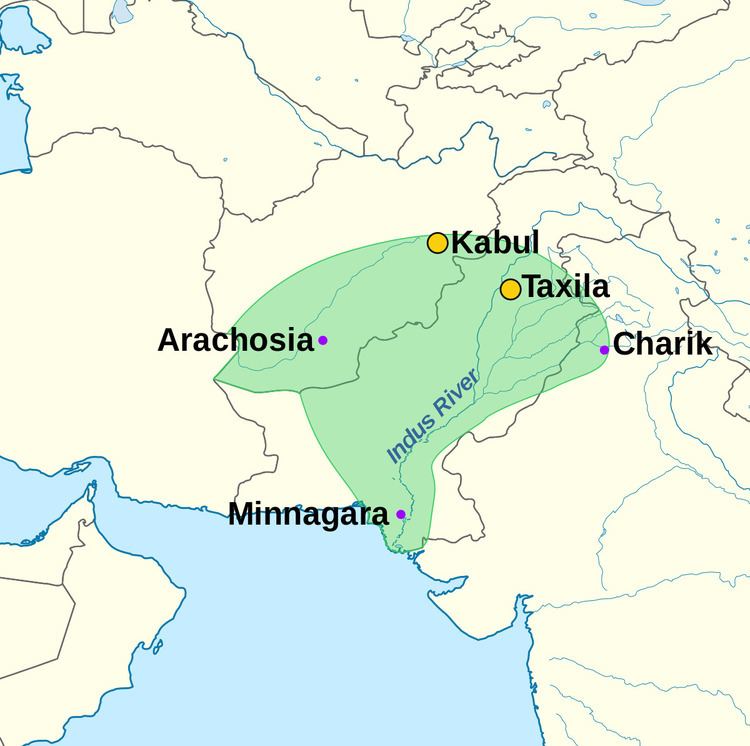Capital Taxila
Kabul 20 BCE Gondophares I | Government Monarchy Historical era Antiquity | |
 | ||
Languages Aramaic
Greek (Greek alphabet)
Pali (Kharoshthi script)
Sanskrit, Prakrit (Brahmi script) Parthian (Parthian script) Religion Zoroastrianism
Buddhism
Hinduism
Ancient Greek religion | ||
The Indo-Parthian Kingdom was ruled by the Gondopharid dynasty and other rulers who were a group of ancient kings from Central Asia that ruled parts of present-day Afghanistan, Pakistan and northwestern India, during or slightly before the 1st century AD. For most of their history, the leading Gondopharid kings held Taxila (in the present Punjab province of Pakistan) as their residence, but during their last few years of existence the capital shifted between Kabul and Peshawar. These kings have traditionally been referred to as Indo-Parthians, as their coinage was often inspired by the Arsacid dynasty, but they probably belonged to a wider groups of Iranian tribes who lived east of Parthia proper, and there is no evidence that all the kings who assumed the title Gondophares, which means ”Holder of Glory”, were even related.
Contents
Gondophares I and his successors
Gondophares I originally seems to have been a ruler of Seistan in what is today eastern Iran, probably a vassal or relative of the Apracarajas. Around 20–10 BCE, he made conquests in the former Indo-Scythian kingdom, perhaps after the death of the important ruler Azes. Gondophares became the ruler of areas comprising Arachosia, Seistan, Sindh, Punjab, and the Kabul valley, but it does not seem as though he held territory beyond eastern Punjab. Gondophares called himself "King of Kings", a Parthian title that in his case correctly reflects that the Indo-Parthian empire was only a loose framework: a number of smaller dynasts certainly maintained their positions during the Indo-Parthian period, likely in exchange for their recognition of Gondophares and his successors. These smaller dynasts included the Apracarajas themselves, and Indo-Scythian satraps such as Zeionises and Rajuvula, as well as anonymous Scythians who struck imitations of Azes coins. The Ksaharatas also held sway in Gujerat, perhaps just outside Gondophares' dominions.
After the death of Gondophares I, the empire started to fragment. The name or title Gondophares was adapted by Sarpedones, who become Gondophares II and was possibly son of the first Gondophares. Even though he claimed to be the main ruler, Sarpedones’ rule was shaky and he issued a fragmented coinage in Sind, eastern Punjab and Arachosia in southern Afghanistan. The most important successor was Abdagases, Gondophares’ nephew, who ruled in Punjab and possibly in the homeland of Seistan. After a short reign, Sarpedones seems to have been succeeded by Orthagnes, who became Gondophares III Gadana. Orthagnes ruled mostly in Seistan and Arachosia, with Abdagases further east, during the first decades AD, and was briefly succeeded by his son Ubouzanes Coin. After 20 AD, a king named Sases, a nephew of the Apracaraja ruler Aspavarma, took over Abdagases’ territories and became Gondophares IV Sases. According to Senior, this is the Gondophares referred to in the Takht-i-Bahi inscription.
There were other minor kings: Sanabares was an ephemeral usurper in Seistan, who called himself Great King of Kings, and there was also a second Abdagases Coin, a ruler named Agata in Sind, another ruler called Satavastres Coin, and an anonymous prince who claimed to be brother of the king Arsaces, in that case an actual member of the ruling dynasty in Parthia.
But the Indo-Parthians never regained the position of Gondophares I, and from the middle of the 1st century AD the Kushans under Kujula Kadphises began absorbing the northern Indian part of the kingdom. The last king Pacores (perhaps before 100 AD) only ruled in Seistan and Kandahar.
Silk Road transmission of Buddhism
Some pocket of Parthian rule remained in the East, even after the takeover by the Sassanids in 226. From the 2nd century several Central-Asian Buddhist missionaries became in the Chinese capital cities of Loyang and sometimes Nanjing, where they particularly distinguished themselves by their translation work. The first known translators of Buddhist texts into Chinese are actually Parthian missionaries, distinguished in Chinese by their Parthian surname "An", for "Anshi", "country of the Arsacids".
